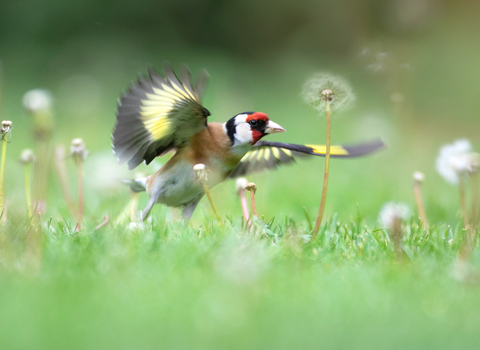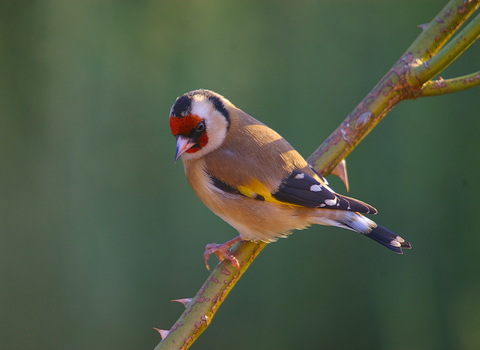
Jon Hawkins, Surrey Hills Photography

©Neil Aldridge
Goldfinch
Scientific name
Carduelis carduelisWhen to see
January to DecemberSpecies information
Category
Statistics
Length: 12-14cmWingspan: 24cm
Weight: 17g
Average lifespan: 2 years
About
The goldfinch is a striking, small finch of gardens, parks, woodland, heathland and farmland. It eats small seeds, especially from ragwort, dandelions and teasels (their long, pointed bills help them to extract the seeds), as well as invertebrates. It will visit birdtables and feeders, too. During winter, goldfinches roam about in flocks of up to 100 birds, searching for food. However, some of our UK birds will migrate as far south as Spain to avoid the worst of the harsh weather.How to identify
The goldfinch is a small, colourful finch that is gingery-brown above and pale below, with black-and-yellow wings, a black crown, white cheeks and a bright red face.Distribution
Widespread, but absent from the very north of Scotland.In our area
When Autumn arrives, look out for goldfinches feeding on teasels and other seed heads around arable fields and pastures. In some areas where roadside verges have been managed to provide more wildlife benefits in the Shropshire Hills, they are regularly seen perching on the tops of hedges. In the Telford area, goldfinches even gather in the greenspaces around the boundaries of industrial estates, which are often left unkempt for much of the year, but with a huge benefit to wildlife.
Goldfinches are becoming increasingly common visitors to suburban gardens, particularly when feeders are topped up with niger seed, which provides them with a decent nutritional alternative to the grass and thistle seeds they would usually eat in the wild.
A great (and much more natural way) to encourage them to your garden is to plant lots of thistles, teasels and other small seed bearing plants around the garden. They also love sunflower seeds, so if you have grown sunflowers in the summer, don't cut them down as they start to droop, leave them standing as long as there are still seeds in the head and you'll be rewarded with some particularly colourful garden visitors!
Did you know?
The collective noun for a group of goldfinches is a 'charm', whereas a group of crows is known as a 'murder', and a group of owls as a 'parliament'. All quite fitting to our stereotypical views of these birds!Watch
Goldfinch (https://vimeo.com/444890022)
Goldfinch by John Bridges
When Autumn arrives, look out for goldfinches feeding on teasels and other seed heads around arable fields and pastures. In some areas where roadside verges have been managed to provide more wildlife benefits in the Shropshire Hills, they are regularly seen perching on the tops of hedges. In the Telford area, goldfinches even gather in the greenspaces around the boundaries of industrial estates, which are often left unkempt for much of the year, but with a huge benefit to wildlife.
Goldfinches are becoming increasingly common visitors to suburban gardens, particularly when feeders are topped up with niger seed, which provides them with a decent nutritional alternative to the grass and thistle seeds they would usually eat in the wild.
A great (and much more natural way) to encourage them to your garden is to plant lots of thistles, teasels and other small seed bearing plants around the garden. They also love sunflower seeds, so if you have grown sunflowers in the summer, don't cut them down as they start to droop, leave them standing as long as there are still seeds in the head and you'll be rewarded with some particularly colourful garden visitors!

